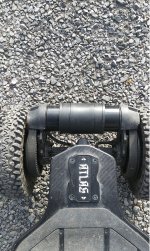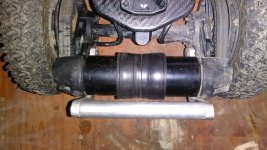JRP3
1 kW
I came up with one possible solution to low traction wheel slip since I haven’t been able to find a dual shaft motor. I made a “limited slip differential” for the board so I could have the 2 front motors turning together when taking off in low traction situations. Seems to be working pretty well off road so far, I even get a bit of slip when carving on pavement, I put some strips of tape on the coupler and the motors to see if they ever rotate independently and they do to some degree. It’s a 1.5 inch flexible pipe coupler that was able to stretch around the slightly more than 2 inch diameter of the motors with some work. The only down side is I have to remove a motor to get it on and off, though I could slit it and use zip ties or hose clamps, which would allow some adjustment of pressure and slippage. I did find after riding about 5 miles on pavement that the rubber sleeve started to migrate to one side so I need to put zip ties or something on the motors to prevent slippage. Just had a thought that I could adjust the amount of slip by biasing the rubber sleeve more to one motor which would provide greater grip on that motor while reducing contact and grip on the other to allow more slip. Or slide it completely off of one motor for road use.




